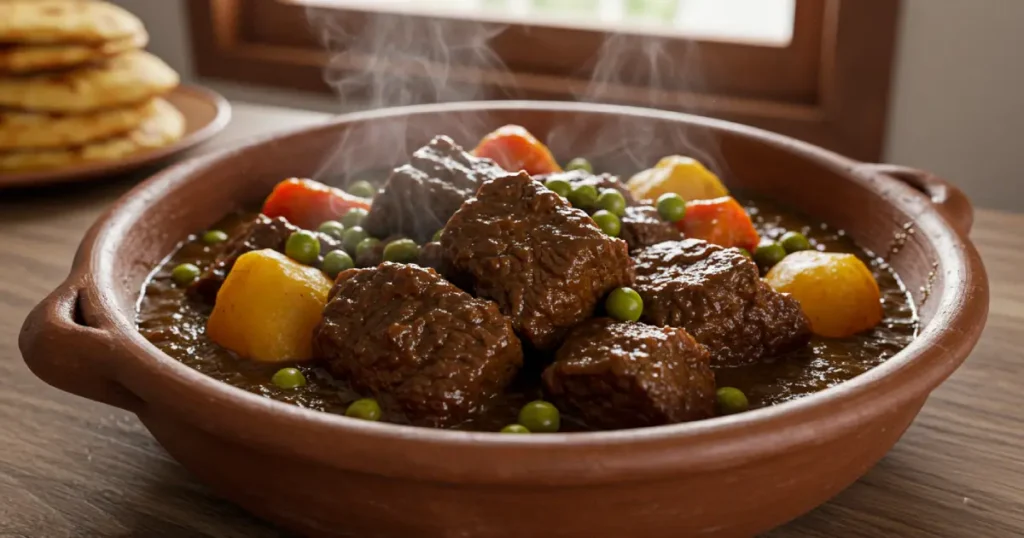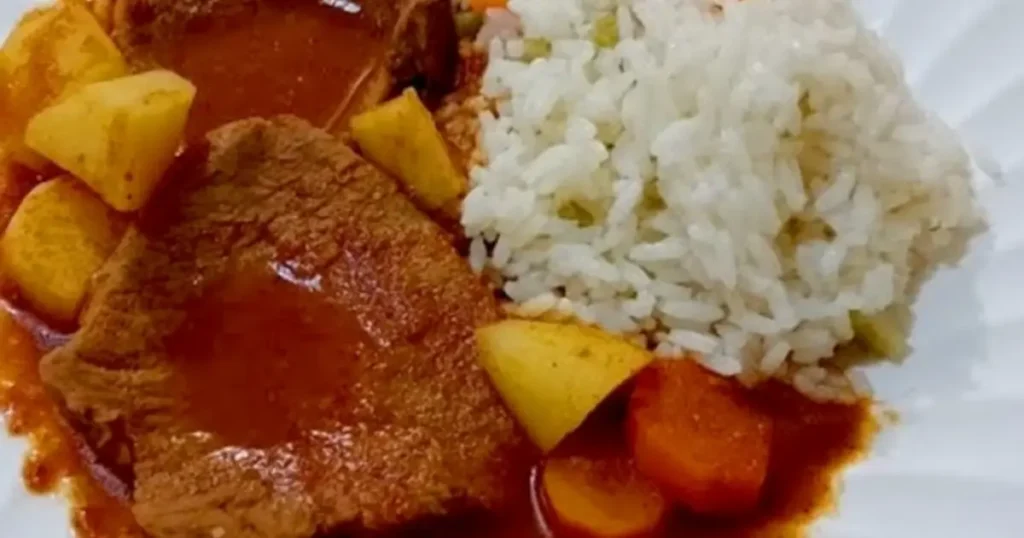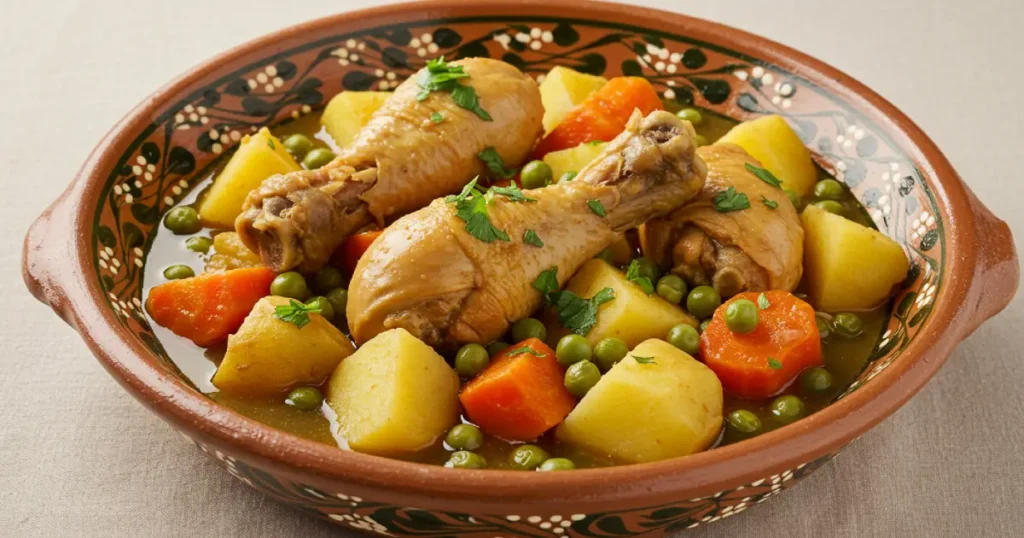Estofado de Res Guatemala: Authentic Guatemalan Beef Stew Recipe & Tradition

Guatemalan cuisine, a vibrant tapestry woven with Mayan heritage and Spanish colonial influences, offers a plethora of flavors and dishes that speak to the soul. Among these culinary treasures, Estofado de Res Guatemala stands out as a beloved comfort food, a hearty stew that graces family tables and warms hearts across the nation.
This traditional beef stew, rich in flavor and steeped in history, is more than just a meal; it's an experience, a culinary hug that embodies the warmth and hospitality of Guatemalan culture. Perfect for a family luncheon or a comforting dinner, estofado is a dish that invites sharing and celebration.
Join us as we delve into the delicious world of Guatemalan estofado, exploring its origins, cultural significance, and, of course, a practical recipe to bring this authentic taste of Guatemala into your own kitchen.
What is Estofado? A Culinary Embrace from Guatemala

At its core, estofado refers to a slow-cooked stew, a technique prevalent in many Latin American countries, each with its unique local twist. The word itself comes from the Spanish "estofar," meaning to stew or to braise. This cooking method involves simmering meat and vegetables in a flavorful liquid over a low heat for an extended period, resulting in incredibly tender meat and a rich, concentrated sauce.
Defining Estofado: More Than Just a Stew
While the basic concept of stewing is universal, an estofado Guatemala distinguishes itself through its specific blend of ingredients and the cultural context in which it's prepared and enjoyed. It’s a dish characterized by its savory depth, often achieved through a harmonious combination of fresh vegetables, aromatic herbs, and tender, slow-cooked beef. Unlike lighter soups, an estofado is typically more substantial, with a thicker sauce that clings to the meat and vegetables, making it a truly satisfying meal. It’s a culinary testament to the art of slow cooking, where time and patience transform simple ingredients into something extraordinary.
The Guatemalan Touch: Unique Flavors and Ingredients

The Guatemalan version of estofado, particularly estofado de res de Guatemala, often features a sofrito base – a sautéed mixture of aromatics that forms the flavor foundation of the dish. Key ingredients typically include onions, tomatoes, and bell peppers, which are cooked down to create a sweet and savory base. The choice of herbs and spices can vary slightly from region to region or even family to family, but cilantro and parsley are common additions, lending a fresh, herbaceous note.
What truly sets it apart is the careful balance of these components, creating a stew that is both robust and nuanced. Often, root vegetables like potatoes and carrots are added, not only for flavor and texture but also to make the dish even more hearty and complete.
Sometimes, green peas are incorporated towards the end of the cooking process, adding a pop of color and a touch of sweetness. The slow simmering process allows the beef to become fork-tender, absorbing all the delicious flavors of the surrounding sauce and vegetables.
The Heart of Guatemalan Home Cooking: The Cultural Significance of Estofado de Res
Estofado de Res is more than just a collection of ingredients simmered in a pot; it's a cornerstone of Guatemalan home cooking and holds significant cultural importance. It’s a dish that evokes a sense of nostalgia and comfort for many Guatemalans, often associated with cherished family moments.
A Dish for Sharing: Estofado at Family Tables
In Guatemala, food is intrinsically linked to family and community. The estofado de res Guatemala is frequently the centerpiece of Sunday lunches or family gatherings. The preparation itself can be a communal activity, with different family members contributing to the process.
The large, steaming pot of estofado, when brought to the table, signifies togetherness and shared enjoyment. Its rich aroma fills the home, creating an inviting atmosphere that draws everyone together. The act of serving and sharing this hearty stew reinforces bonds and creates lasting memories. It’s a dish that nourishes not only the body but also the spirit of familial connection.
Celebrations and Special Occasions
While enjoyed as a regular family meal, estofado can also feature in celebrations and special occasions. It might be prepared for a birthday, a local festival, or simply when hosting honored guests. Its presence on the menu elevates the occasion, signifying hospitality and a desire to share the best of Guatemalan home cooking. The effort and time that go into making a truly delicious estofado are seen as an expression of care and affection for those who will be partaking in the meal.
Regional Nuances in Guatemalan Cuisine
Guatemala is a country of diverse landscapes and microclimates, and this diversity is reflected in its cuisine. While the core concept of estofado de guatemala remains consistent, there can be subtle regional variations. Some areas might incorporate a local chili for a hint of spice, while others might use slightly different herbs or vegetables based on seasonal availability.
For instance, in cooler highland regions, a heartier version might be preferred, perhaps with additional root vegetables. Coastal areas might have their own stews with different protein bases, but the essence of a slow-cooked, flavorful dish remains a common thread. These variations, however subtle, add to the rich tapestry of Guatemalan food culture, showcasing the adaptability and ingenuity of local cooks.
Crafting Your Own Estofado de Res de Guatemala: A Step-by-Step Guide
Bringing the authentic taste of estofado de res de Guatemala into your home is a rewarding culinary journey. This recipe, based on traditional Guatemalan home cooking, will guide you through creating a delicious and comforting stew.
Gathering Your Ingredients
The quality of your ingredients will significantly impact the final flavor of your estofado. Here’s what you’ll need:
- For the Beef and Base:
- 1 pound of beef (such as chuck roast, round steak, or stewing beef), cut into 1 to 1.5-inch cubes
- 2 tablespoons of vegetable oil
- 1 beef bouillon cube (or 1 cup of beef broth, in which case you may need to adjust added water later)
- Aromatics and Vegetables:
- 3 sprigs of white spring onions (or the white part of 2-3 leeks), chopped
- 1 medium white or yellow onion, chopped
- 1 green bell pepper, stemmed, seeded, and chopped
- 2 large ripe tomatoes, chopped
- 1 large carrot, peeled and diced into small cubes
- 3 medium potatoes (about 1-1.5 pounds), peeled and cut into 1-inch cubes
- ½ cup of fresh or frozen green peas
- Herbs and Seasonings:
- 3 tablespoons of fresh parsley, finely chopped
- 3 tablespoons of fresh cilantro, finely chopped
- Salt and freshly ground black pepper to taste
- Liquid:
- Boiling water, as needed (approximately 2-3 cups, depending on desired consistency)
Ingredient Notes:
- The Beef: Choosing a cut with some marbling, like chuck, will result in more tender and flavorful meat after slow cooking.
- Vegetables: Freshness is key. The combination of onions, bell pepper, and tomatoes creates a classic sofrito that is fundamental to the stew's flavor profile.
- Herbs: Fresh parsley and cilantro add a burst of brightness. If fresh isn't available, you can use dried, but reduce the quantity by about two-thirds and add them earlier in the cooking process.
The Art of Preparation: Bringing the Flavors Together
Follow these steps carefully to create a rich and flavorful estofado Guatemala.
1. Prepping the Vegetables: A Foundation of Freshness Begin by preparing all your vegetables as indicated. Chop the spring onions, white/yellow onion, green bell pepper, and tomatoes into relatively small, uniform pieces. Dice the carrot into small cubes. Peel and cube the potatoes, keeping them in a bowl of water until ready to use to prevent browning. This initial preparation, or "mise en place," will make the cooking process smoother.
2. Building the Sofrito: The Flavor Powerhouse In a large, heavy-bottomed pot or Dutch oven, heat the 2 tablespoons of oil over medium heat. Once the oil is shimmering, add the chopped spring onions, white/yellow onion, and green bell pepper. Sauté for 5-7 minutes, stirring occasionally, until the vegetables soften and the onions become translucent. Next, add the chopped tomatoes, the crumbled beef bouillon cube (if using), 2 tablespoons of the chopped parsley, and 2 tablespoons of the chopped cilantro.
If you have a preferred homemade seasoning blend ("aliño casero" as sometimes used in Guatemalan homes, which might include garlic, cumin, or other spices), you can add a teaspoon or two here. Stir well and cook for another 5-8 minutes, allowing the tomatoes to break down and the flavors to meld, creating a fragrant sofrito. Add the diced carrots at this stage as well. Season with a pinch of salt and freshly ground black pepper. Remember that the bouillon cube also contains salt.
3. Searing and Simmering the Meat: Locking in the Juices Add the cubed beef to the pot with the sofrito. Stir to coat the meat with the vegetable mixture. Continue to cook over medium heat, stirring occasionally, until the beef is lightly browned on all sides. This step helps to develop a deeper flavor. Once the meat is browned, reduce the heat to low, cover the pot, and let the meat cook in its own juices and the sofrito for about 15-20 minutes. This allows the meat to start tenderizing and absorb the initial flavors.
4. The Slow Simmer: Developing Depth and Tenderness After the initial covered cooking, check the pot. The mixture might seem a bit dry. Begin adding boiling water, one cup at a time, just enough to keep the ingredients moist and prevent sticking. You don't want to drown the meat entirely at this stage, but ensure there's enough liquid for a gentle simmer.
Cover the pot again and let the estofado de res guatemala simmer gently over low heat. This slow cooking process is crucial for tenderizing the beef. Check periodically, every 20-30 minutes, stirring gently and adding more boiling water as needed to maintain a saucy consistency. The total simmering time for the beef at this stage could be 1 to 1.5 hours, or until the beef is becoming tender.
5. Adding the Finishing Touches: Potatoes and Peas While the beef is simmering, if you are using fresh peas that require separate cooking, bring a small pot of water to a boil. Add the fresh peas and cook for 3-5 minutes until tender-crisp. Drain and set aside. If using frozen peas, you can add them directly to the stew later. Once the beef is almost tender (you can test a piece with a fork), add the cubed potatoes to the pot. Stir gently to incorporate them. If needed, add a little more boiling water to ensure the potatoes are mostly submerged in liquid.
Continue to simmer, covered, for another 20-30 minutes, or until the potatoes are cooked through and tender. During the last 5-10 minutes of cooking, stir in the cooked fresh peas (or frozen peas) and the remaining 1 tablespoon of chopped parsley and 1 tablespoon of chopped cilantro. Taste the stew and adjust seasoning with salt and pepper if necessary.
6. Rest and Serve Once the potatoes are soft and the beef is perfectly tender, turn off the heat. Allow the estofado to rest for at least 10-15 minutes before serving. This allows the flavors to meld even further.
Tips for the Perfect Estofado Guatemala

- Low and Slow: The secret to exceptionally tender beef in your estofado de guatemala is a long, slow simmer. Don't rush this process.
- Adjusting Seasoning: Taste the stew at various stages, especially before serving, and adjust salt and pepper as needed. The flavors will concentrate as it cooks.
- Achieving the Right Consistency: Some prefer a thicker stew, others a bit more brothy. You can control this by how much water you add. If your stew is too thin at the end, you can remove the lid and simmer for a few extra minutes to allow some liquid to evaporate, or mash a few pieces of cooked potato against the side of the pot to help thicken the sauce naturally.
- Quality of Beef: Using a good quality stewing beef with some marbling will yield a more tender and flavorful result.
- Fresh Herbs: While dried herbs can be substituted, fresh parsley and cilantro added towards the end of cooking significantly brighten the flavors of the estofado guatemala.
Serving Suggestions: Completing Your Guatemalan Feast
The estofado de res Guatemala is a hearty and complete meal in itself, but serving it with traditional accompaniments elevates the experience.
Classic Pairings: White Rice and Fresh Tortillas
The most common and beloved way to serve estofado in Guatemala is with a generous portion of fluffy white rice. The rice acts as a perfect vehicle to soak up the rich, flavorful sauce of the stew. Many families also serve fresh corn tortillas alongside. These warm tortillas can be used to scoop up the meat and vegetables or to savor the last bits of sauce from the plate. The combination of the savory stew, the neutral rice, and the earthy tortillas is a match made in culinary heaven.
Accompaniments and Garnishes
For an extra touch of freshness and flavor, consider these simple accompaniments or garnishes:
- Sliced Avocado: A few slices of creamy avocado on the side or on top add a lovely textural contrast and richness.
- Fresh Cilantro: A final sprinkle of freshly chopped cilantro just before serving can brighten the dish.
- Lime Wedges: A squeeze of fresh lime juice can add a zesty note that cuts through the richness of the stew, though this is more common with other Guatemalan dishes, some might enjoy it.
- Picado de Rábano (Radish Salad): A simple, tangy radish salad can offer a refreshing counterpoint.
Estofado Beyond the Recipe: Exploring Variations and Modern Twists
While the classic estofado de res de Guatemala is a cherished tradition, the concept of estofado is versatile, allowing for variations and adaptations.
Different Meats: Chicken or Pork Estofado
The same slow-cooking technique and flavor base can be wonderfully applied to other proteins. Chicken estofado (Estofado de Pollo) is a lighter but equally delicious alternative. Pork estofado (Estofado de Cerdo), using cuts like pork shoulder, also yields a rich and tender stew. The cooking times might need adjustment based on the protein used, but the fundamental approach remains similar.

Vegetarian Adaptations
For a vegetarian take on the Guatemalan estofado, one could create a robust stew using a variety of hearty vegetables. Think mushrooms (like portobello or shiitake for a "meaty" texture), chickpeas or other beans for protein, and a greater assortment of root vegetables like sweet potatoes, yuca, or plantains. The key would be to build a deeply flavorful vegetable broth and sofrito to mimic the richness of the traditional version.
Modern Interpretations in Guatemalan Restaurants
Contemporary Guatemalan chefs are also reinterpreting traditional dishes like estofado. You might find versions in upscale restaurants that use premium cuts of meat, incorporate less common local ingredients, or present the dish with modern plating techniques. These interpretations help to keep the tradition alive while also showcasing the evolution of Guatemalan cuisine. These innovative approaches often highlight the versatility of an estofado de guatemala, demonstrating how traditional flavors can be presented in new and exciting ways.
The Enduring Appeal of Estofado de Guatemala
The enduring appeal of estofado de res Guatemala lies in its comforting nature, its rich flavors, and its deep connection to Guatemalan family life and traditions. It’s a dish that tells a story of shared meals, of time-honored cooking methods, and of the simple joy of good food made with care. Whether it's a chilly evening or a Sunday family gathering, a bowl of estofado offers warmth, nourishment, and a taste of Guatemalan heritage.
We encourage you to embark on the culinary adventure of making your own estofado guatemala. It's more than just following a recipe; it's about connecting with a culture, creating something delicious with your own hands, and sharing it with loved ones. The process itself, from chopping the fresh vegetables to the slow simmer that fills your kitchen with enticing aromas, is part of the charm.
Conclusion: Experience the Warmth of Guatemala Through Its Estofado
The estofado de res de Guatemala is a testament to the beauty of slow-cooked, heartfelt cuisine. It embodies the spirit of Guatemalan hospitality and the importance of family and shared meals. By preparing this dish, you are not just making a stew; you are partaking in a tradition, creating an opportunity for connection, and savoring a truly authentic flavor of Central America. So gather your ingredients, allow the pot to simmer patiently, and get ready to enjoy one of Guatemala's most cherished culinary offerings. Buen provecho!

Leave a Reply